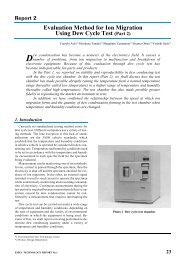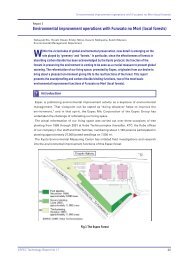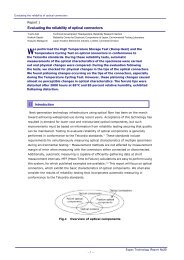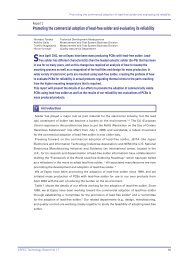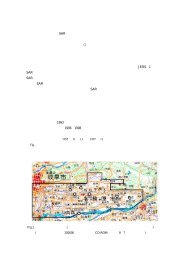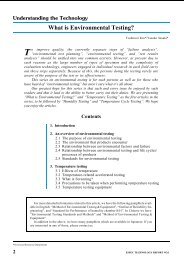Measuring conductivity of proton conductive membranes in the ...
Measuring conductivity of proton conductive membranes in the ...
Measuring conductivity of proton conductive membranes in the ...
Create successful ePaper yourself
Turn your PDF publications into a flip-book with our unique Google optimized e-Paper software.
<strong>Measur<strong>in</strong>g</strong> <strong>conductivity</strong> <strong>of</strong> <strong>proton</strong> <strong>conductive</strong> <strong>membranes</strong> <strong>in</strong> <strong>the</strong> direction <strong>of</strong> thickness<br />
[Term<strong>in</strong>ology]<br />
*1.Cell constant<br />
Typically, electrical <strong>conductivity</strong> <strong>of</strong> a material can be expressed as<br />
σ=L/(A·R)=k/R, where L is <strong>the</strong> length (cm) <strong>of</strong> <strong>the</strong> material <strong>in</strong> electronic flow, A is<br />
<strong>the</strong> sectional area (cm2 ) across <strong>the</strong> flow <strong>of</strong> <strong>the</strong> material, R is <strong>the</strong> measured resistance<br />
(Ω), and k=L/A, <strong>the</strong> proportionality factor, is called <strong>the</strong> cell constant. The electrical<br />
<strong>conductivity</strong> <strong>of</strong> <strong>the</strong> material is <strong>in</strong> direct proportion to <strong>the</strong> reciprocal <strong>of</strong> <strong>the</strong> measured<br />
resistance between <strong>the</strong> electrodes by <strong>the</strong> scale factor, k, which represents <strong>the</strong><br />
<strong>in</strong>fluence <strong>of</strong> <strong>the</strong> dimensions <strong>of</strong> <strong>the</strong> measur<strong>in</strong>g cell.<br />
*2.Conductivity measurement us<strong>in</strong>g <strong>the</strong> 4-probe method<br />
As one method for measur<strong>in</strong>g <strong>the</strong> electrical <strong>conductivity</strong> <strong>of</strong> materials, <strong>the</strong> 4-probe<br />
method possesses much higher measurement precision than <strong>the</strong> 2-probe method.<br />
Two term<strong>in</strong>als are used to conduct a current through <strong>the</strong> sample, and ano<strong>the</strong>r two<br />
term<strong>in</strong>als measure <strong>the</strong> potential drop across <strong>the</strong> sample.<br />
*3.Proton-<strong>conductive</strong> membrane<br />
When potential difference exists <strong>in</strong> a conductor, electrical charges move <strong>in</strong> <strong>the</strong><br />
direction required to weaken <strong>the</strong> difference. The property <strong>of</strong> this conductor is called<br />
its electrical conduction. When <strong>proton</strong>s exist <strong>in</strong> <strong>the</strong> conductor as <strong>the</strong> ma<strong>in</strong> current<br />
carriers, <strong>the</strong> material is referred to as <strong>proton</strong> conduction, and <strong>the</strong> quality or power <strong>of</strong><br />
<strong>the</strong> conduction is called <strong>proton</strong> <strong>conductivity</strong>. Some membrane materials, typically<br />
consist<strong>in</strong>g <strong>of</strong> such as <strong>in</strong>organic compounds <strong>of</strong> ceramics and/or glass, organic<br />
polymer compounds, and <strong>in</strong>organic/organic hybrid materials, exhibit high H + ion<br />
conduction. Proton exchange <strong>membranes</strong> based on fluor<strong>in</strong>ated polymers as typified<br />
by Nafion ® have been widely used <strong>in</strong> solid polymer electrolyte fuel cells (PEFCs) due<br />
to <strong>the</strong>ir high <strong>proton</strong> <strong>conductivity</strong> (to 0.1 Scm-1 ) and chemical stability.<br />
*4.Conductivity measurement us<strong>in</strong>g <strong>the</strong> 2-probe method<br />
As <strong>the</strong> simplest and most straightforward method for measur<strong>in</strong>g electrical<br />
<strong>conductivity</strong>, <strong>the</strong> 2-probe method uses only two term<strong>in</strong>als that share <strong>the</strong> functions<br />
<strong>of</strong> both <strong>in</strong>troduction <strong>of</strong> current (I) and measurement <strong>of</strong> voltage (V) across <strong>the</strong><br />
sample. The electrical <strong>conductivity</strong> <strong>of</strong> a specimen can be calculated with <strong>the</strong> formula<br />
<strong>of</strong> σ=(I·L)/(V·A), provided that sectional area (A) and length (L) <strong>of</strong> <strong>the</strong> specimen are<br />
measured.<br />
*5.Membrane electrode assembly (MEA)<br />
An electrode layer composed <strong>of</strong> plat<strong>in</strong>um black or plat<strong>in</strong>um-support<strong>in</strong>g carbon and a<br />
porous support<strong>in</strong>g collector layer composed <strong>of</strong> carbon paper or carbon cloth<br />
arranged <strong>in</strong> succession on both sides <strong>of</strong> a cation exchange membrane, with <strong>the</strong><br />
assembly unified by hot-press<strong>in</strong>g, is called a membrane electrode assembly (MEA).<br />
[Bibliography]<br />
1)http://www.fuelcells.dupont.com/<br />
2)Y. Sone, et al., J. Electrochem. Soc., 143, p.1254, 1996<br />
3)K. M. Cable et al., Chem. Mater., 7, p.1601, 1995<br />
4)A. Kuse, S. Ma, A. Mizugaki, H. Okuda, Z. Siroma, T. Ioroi, K. Yasuda, Y. Miyazaki;<br />
11th FCDIC Fuel Cell Symposium Proceed<strong>in</strong>gs, p.262, 2004<br />
- 20 -<br />
Espec Technology Report No20



